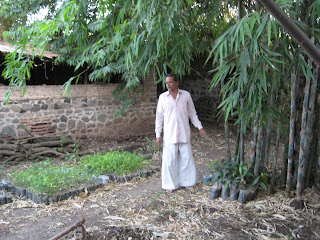 Some impressions from my recent "exposure" stay in an Indian village -- in Nasik district, Maharashtra: Having lived in Indian villages before, I was really surprised to see how much the Indian countryside is changing these days.
Some impressions from my recent "exposure" stay in an Indian village -- in Nasik district, Maharashtra: Having lived in Indian villages before, I was really surprised to see how much the Indian countryside is changing these days.growing capsicum in the greenhouse
First of all how much the production is targeted to far-away markets, how much the village is part of the global economy. Many farmers in Maharashtra produce grapes for export these days, wine is being made for customers abroad, and genetically modified "BT cotton" is grown. These farmers are very active, constantly on the look for new technologies and markets. They use a lot of "modern" technology such as fertilizers, machines, pesticides, sophisticated irrigation and GM plants. They take huge loans to invest in their crops, and many earn "lakhs" of Rupees (thousands of Euros) after paying back their loans with the harvest. At the same time, the landless labourers (in this village 70 per cent of the population) still have to live on 40 Rs. (women) or 55-60 Rs. (men) of daily earnings - less than one Euro a day...
environmental concerns
But innovation is also going in other directions: There is a growing number of organic farmers in Maharashtra who stop using pesticides and chemical fertilizer. This 73-year-old farmer has developed his own theory of "natural farming": He doesn't even buy organic fertilizer, and claims he is still making money. As an additional activity, he has planted hundreds of thousands of trees and is distributing the saplings free of cost to anyone who wants them.
a model village
Most interesting about the particular village I lived in was to see how much the villagers had done for development over the last few years: They had managed to convince everyone there to build a toilet in their house, and to use it, too... They had established small savings and loans groups for women. As a reward, they got water connections for every house from the state government (which has given up the top-down approach to development and requests the citizens to share responsibilities). They were proud that they didn't have elections for the village council (which led to infighting in neighbouring villages), but nominated only as many candidates as there were posts on the basis of consensus...
harmony, not rivalry
The villagers tried to sort out conflicts themselves through a special committee, and had managed to keep the police out of the village in this way. They stressed that political parties and caste rivalries don't matter. Of course, there have always been symbols of harmony in the Indian countryside, and I found a nice one there, too: In this village without any Muslim inhabitant, the Hindu villagers maintained, decorated and worshipped the tomb of a Muslim saint.




No comments:
Post a Comment